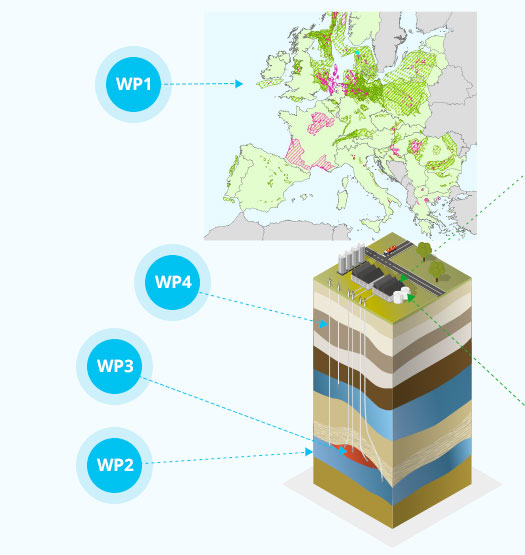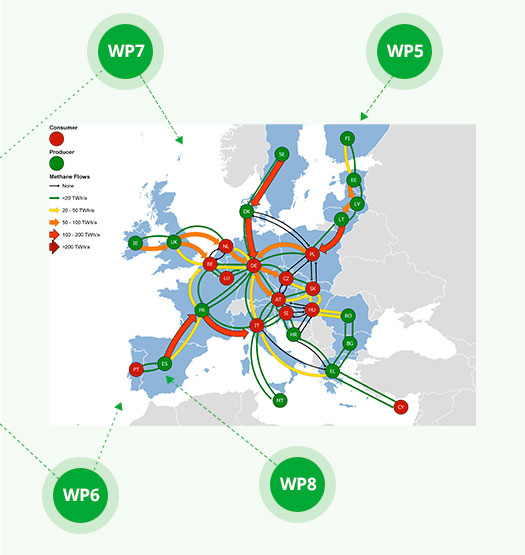
Hystories
HYdrogen STORage In European Subsurface
……………………
While storing pure hydrogen in salt caverns has been practiced since the 70s in Europe, pure hydrogen storage has not yet been carried out yet anywhere in depleted fields or aquifers. Hystories will deliver technical developments applicable to a vast range of future aquifer or depleted field sites,
will conduct techno-economic feasibility studies and provide insights into underground hydrogen storage for decision makers in government and industry.
Project objectives
Technology development, Techno-economic
feasibility studies, Implementation plan
……………………
Deliver public subsurface technical developments for pure hydrogen storage in depleted fields or aquifers:
- Improve geological characterization at large scale and build / consolidate / mature a database of storage opportunities,
- Answer reservoir engineering questions such as effects of mixing,
mobility impact on structural trapping and geochemical interactions
between hydrogen and rocks, - Determine expected microbial activity and impacts from
a wide range of relevant geological conditions, - Develop strategies for longer-lasting wells in this potentially
aggressive environment.
Provide techno-economic insights on hydrogen underground storage deployment in the Europe-an energy system:
- Define the hydrogen storage demand under various scenarios
and time horizons - Review the regulatory framework, and prepare Environmental
and social life-cycle assessment - Estimate the cost of developing storage sites candidates
and propose ranking them throughout Europe. - Assess economic opportunities and implementation potential for
a large-scale storage of renewable hydrogen for several case studies
The final outcome of the project will be assessments of techno-economic feasibility of implementing hydrogen storage
in preferred locations, to enable informed decision making on pilot demonstration and industrial deployment.
Work Packages (WP)
……………………
Subsurface technology development

WP1 Geological assessment
WP1 Geological assessment will advance a database of geological storage opportunities both on and offshore through addition of data with specific relevance to geological storage of hydrogen: improvements will be at the European scale, Hystories being able to collate data for at least 19 European countries.
WP2 Reservoir engineering and geochemistry
WP2 Reservoir engineering and geochemistry will investigate hydrodynamical (i.e. fluid flow and mixing) and chemical (i.e. mineral geochemical interactions) issues related to injection of hydrogen into depleted gas reservoirs and aquifers based on specialized geological and geochemical modelling and simulation tools. It will assess and demonstrate if and how hydrogen may be safely stored in depleted hydrocarbon reservoirs or aquifers in Europe, without adverse industrial or technical difficulties.
WP3 Microbiology
WP3 Microbiology will analyse in more detail microbial processes associated with hydrogen in different potential porous underground storages at European level based on formation water and rock samples from various storage formations. It will assess and classify underground storage technologies in respect to the microbial environment and conduct laboratory tests to determine the H2-stimulation potential of microbial processes. Furthermore, based on these results, the work package will model microbial reactivity in full scale storage sites in order to evaluate measures to contain microbial activities.
WP4 Material and corrosion
WP4 Material and corrosion will evaluate various tubing and casing materials for completion in depleted fields or other hydrogen underground storages. This WP will perform a number of different tests including autoclave, permeation and ripple load tests for selected material samples. As result it will define the most adapted grades of materials for its use in underground renewable hydrogen storage sites.
Techno-economic feasibility

WP5 Modelling of the European energy system
WP5 Modelling of the European energy system will investigate the role of a widespread deployment of underground renewable hydrogen storage in the EU in future scenarios across the period 2025-2050. WP5 will model and analyse optimal design and operation of different elements of the future energy system including renewable electricity supply, production of renewable hydrogen, associated gas compression and hydrogen pipeline networks to transfer hydrogen to/from the storage. As an output the model will identify how to match renewable supply with energy demand at all times by appropriately sizing and operating the technologies involved in producing, storing, distributing and using renewable hydrogen.
WP6 Impact studies
WP6 Impact studies will assess the regulatory framework of large-scale hydrogen underground storage technologies at EU-level and analyse the environmental and socio-economic impacts of the underground storage technology in comparison to other large-scale energy storage technologies. The analyses will be based on publicly available data and literature.
WP7 Ranking of geological sites
WP7 Ranking of geological sites will be the major link between the technical subsurface and techno-economic studies. This WP will first provide a conceptual design of an underground storage site and estimate the life cycle cost of developing it. It will also be one of the criteria for the ranking of the sites that can be developed for hydrogen storage, along with technical criteria coming from the developments carried out in WP1 to WP4.
WP8 European case studies
WP8 European case studies will provide an in-depth analysis of single storage sites for France, Germany, Poland and Spain, and one additional EU Member State. This WP will summarize and enhance relevant data on underground hydrogen storage from previous work packages, providing a more detailed country-specific overview with respect to the role of underground renewable hydrogen storage in the selected Member State. It will also perform site-specific profitability analysis taking into account site-specific costs.
WP9 Major conclusions and implementation plan in the EU
WP9 Major conclusions and implementation plan in the EU will draw comprehensive conclusions from the outcome of all other work packages. In this context, this WP will also provide a geographical mapping of the geological and techno-economic results from the feasibility studies along with relevant publicly available data in respect to the proximity of suitable underground stores with existing and potential for wind and solar energy production. Lastly, a European hydrogen underground storage implementation plan will provide substantial insights into the feasibility of implementing such storage across EU and into potentials for positive business cases, bringing rationale for decisions such as whether to proceed to field pilot demonstration.
WP10 Dissemination and communication
WP10 Dissemination and communication will ensure proper and correct information delivery and impact of project development and results. This WP is intended to generate stakeholders’ awareness and to make sure Hystories insights are effectively disseminated amongst decision makers relevant to the implementation of H2 geological storage across EU. Moreover, it will allow for communication of the non-confidential knowledge to the public through organising an international conference.
